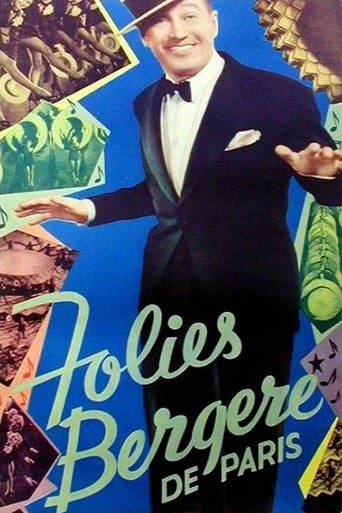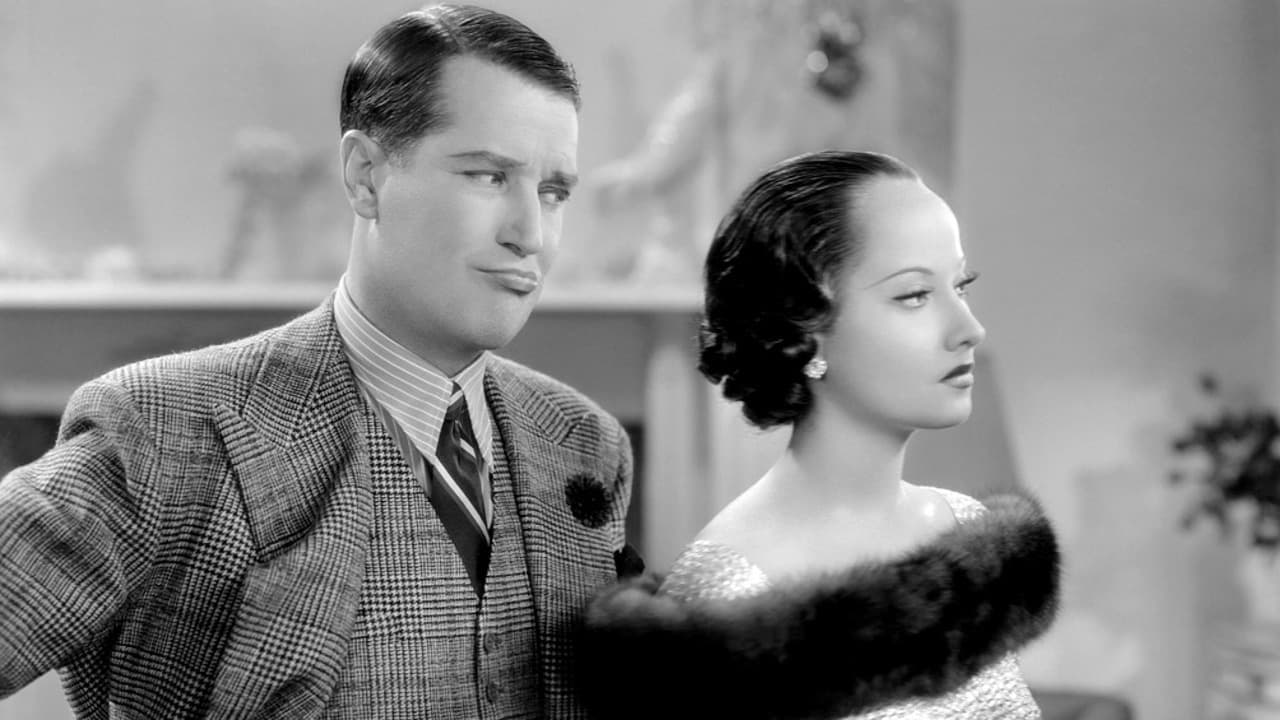JohnHowardReid
Copyright 27 February 1935 by 20th Century Pictures, Inc. Presented by Joseph M. Schenck. Released through United Artists. New York opening at the Rivoli, 24 February 1935. Australian release: 5 June 1935. 9 reels. 83 minutes. U.K. release title: The MAN FROM THE FOLIES BERGERE.SYNOPSIS: Baron hires an impersonator who falls for the Baron's wife.NOTES: Academy Award, Dave Gould, Dance Direction (for the "Straw Hat" number in this film and the "I've Got a Feelin' You're Foolin'" number in Broadway Melody of 1936).Re-made as That Night In Rio (1941) and On the Riviera (1951).A dismal failure on Broadway, The Red Cat opened at the Broadhurst on 19 September 1934 and closed after only 14 performances. Reviews were uniformly scathing: "A dated comedy with an old-hat plot and threadbare situations." Bertram Harrison directed a cast that included Francis Lister (in a dual role as the entertainer who impersonates a look- alike nobleman), Ruth Weston, Tamara Geva, Rex O'Malley, Porter Hall, and Barnett Parker.20th Century made a French version of Folies Bergére simultaneously with the English-language version. And I do mean simultaneously. I've not seen the French version, L'Homme des Folies Bergére, but an examination of the stills reveals that not only were exactly the same camera set-ups employed, but exactly the same extras occupy exactly the same positions in both movies. For this reason, the French version is officially credited to Roy Del Ruth, though the actors were actually directed by Marcel Achard, who translated (and some say improved) the dialogue, while Albert Willemetz re-penned the French song lyrics. Aside from Chevalier, most of the players were replaced. Natalie Paley was assigned the Merle Oberon role, and Sim Viva was Mimi. Others in the French version included André Berley, Jacques Louvigny, Fernand Ledoux, H. Ramsey Hill, André Cheron, Jules Raucourt, Ferdinand Munier, Marcelle Corday, Barbara Leonard, Georges Renavent, Albert Polet, Mario Dominici and Olga Borget.COMMENT: The old The Guardsman plot — deduct five points for censorship emasculation — splendidly enacted by Chevalier and company, with Miss Oberon never looking more beautiful (soft focus photography by Barney McGill and costumes by Omar Kiam) or Miss Sothern more sexy. Director Roy Del Ruth's marvelous sense of comedy and expert timing makes the most of the witty screenplay. The songs are delightfully tuneful and include two fabulous production numbers — Gould won the Dance Direction Academy Award for 1935 — that out-Busby Berkeley. These musical numbers rejoice in sharp photography by Peverell Marley. Richard Day's magnificent sets are also a joy to behold and the sound recording could not be bettered today. The smooth film editing reflects Hollywood craftsmanship at its best. The film is a credit to all involved. Truly outstanding entertainment.
Richard Burin
Folies Bergère de Paris (Roy Del Ruth, 1935) is a Lubitsch-like confection with numbers inspired by the kaleidoscopic choreography of Busby Berkeley. It's also among the best films I've caught this year. The story sees a vaudeville entertainer (Maurice Chevalier with his familiar persona) impersonate a baron (Chevalier again), leading to romantic complications for both. Ann Sothern is the entertainer's good time gal, with Merle Oberon the baron's flighty wife. It's witty and invigoratingly entertaining, with a fine performance by Chevalier in his dual role and a top supporting cast that includes Eric Blore, Robert Greig and Halliwell Hobbes. Despite the enjoyable plotting, the film's finest moments come through the slew of great numbers at both the beginning and the end of the film. The Singing a Happy Song finale, which won an Oscar for dance direction and features several hundred straw hats of varying sizes, is really something, but all the tunes are great: Valentine, Rhythm of the Rain, Au Revoir l'Amour and You Took the Words Right Out of My Mouth. This was Chevalier's last Hollywood musical until Gigi, 23 years later.
MartinHafer
In the early to mid 1930s, Maurice Chevalier made some exceptional American films such as LOVE ME TONIGHT and THE MERRY WIDOW. While I usually am not a fan of Jeanette MacDonald films, his presence elevated them to great heights thanks to his on screen personality and lovely singing voice. While this film is fun and is well worth seeing, it is clearly several steps below these other films in quality--mostly because the script is a tad silly. The main idea is a giant cliché. The audience is supposed to believe that there are two men who are unrelated who look and talk exactly alike. While such an idea worked pretty well in THE PRINCE AND THE PAUPER and THE PRISONER OF ZENDA, here the writing wasn't good enough to enable many audience members to accept this idea--especially because the two are so exact that even a wife cannot tell the difference! If you can ignore the central idea as well as the film going on a bit too long and having too many Busby Berkeley-style dance numbers, you are left with a film that is still worth your time and is a little better than your standard time-passer.
lugonian
FOLIES BERGERE De Paris (20th Century Pictures, 1935), directed by Roy Del Ruth, is the kind of movie musical that typifies the 1930s: mistaken identity, comical character actors, lavish sets, and production numbers in the Busby Berkeley manner. Starring Maurice Chevalier, it offers the legendary French entertainer the opportunity to play two separate characters that bear a close resemblance to one another, one being a music hall headliner with a clean-cut image whose trademark is his straw hat (like Chevalier), while the other sports a mustache, monacle and a touch of gray hair along his temple. Chevalier even gets to perform opposite two leading ladies, one his theatrical partner, the other, his wife. FOLIES BERGERE goes on record as Chevalier's last Hollywood musical for two decades, closing the chapter to this era in his career. Quite popular since his Hollywood debut at the Paramount studio in 1929, Chevalier returned to Europe where he occasionally appeared in movies abroad before beginning a new chapter in his career in 1957 when he returned to Hollywood once again where he would remain for another decade. As for Merle Oberon, she makes her Hollywood debut, appearing more exotic with her Javanese slant eyes and heavy make-up, compared to her more fresh and appealing features shortly after working under producer Samuel Goldwyn guidance where she performed in some of her best screen work, notably WUTHERING HEIGHTS (1939). Ann Sothern, a bright young blonde comedienne who found popularity in later years at MGM and on television, provides good opportunity in being both amusing and annoying as Chevalier's temperamental and jealous girlfriend, Mimi. The fun gets underway when Eugene Carlier (Maurice Chevalier), an entertainer at the Folies Bergere, doing a famed impersonation of the Baron Fernand Cassini (Chevalier), a banker, who, by chance, happens to be sitting in the audience with his stately wife, Genevieve (Merle Oberon). Because of a financial crisis that has put his fortune in jeopardy, the Baron decides he must acquire 20 million francs by leaving town to raise the needed cash. During his absence, Eugene is hired to impersonate the Baron at a social function in the home of the Baron. After being instructed in how to act and what to say, Eugene goes on with his masquerade. Because the deception is unknown to Genevieve, confusion arises, and when she learns of the plan, decides to have her fun with the entertainer, unaware that her husband has actually returned home earlier than expected, at the very moment Eugene had made his hasty departure to attend a performance. Believing the Baron to be Eugene, Genevieve finds herself flirting with her own husband. More confusion occurs when Mimi (Ann Sothern), Eugene's musical partner, mistakes him for the Baron, adding more enjoyment to the story long before it is over. On the musical program, songs include: "Valentine" (sung by Maurice Chevalier) by Andre Christian, Albert Willmetz, with English lyrics by Herbert Reynolds; "Rhythm in the Rain" (sung by Chevalier and Ann Sothern) by Jack Meskill and Jack Stern; "Au Revoir L'Amour," "You Took the Words Right Out of My Mouth" by Harold Adamson and Burton Lane); "I Was Lucky" and the grand finale of "Singing a Happy Song" (sung and performed by Chevalier and Ann Sothern). "Rhythm in the Rain" is an entertaining production number inspired by "Singin' in the Rain," obviously, but is surpassed by "Happy Song," better known as "The Straw Hat Number," paying homage to Chevalier's prop and image, winning an Academy Award as Best Dance Direction, as choreographed by Dave Gould, beating out Busby Berkeley's more imaginable and longer production number of "The Lullaby of Broadway" from GOLD DIGGERS OF 1935 (Warner Brothers).Unlike earlier night club musicals of the period, namely WONDER BAR (Warner Brothers, 1934) starring Al Jolson, FOLIES BERGERE does not take place entirely at the famous nightclub, but centers upon the entertainers who work there. The storyline comes between the opening and closing song numbers, where most of the plot is set at the estate of the Baron. At times, FOLIES BERGERE has that Warner Brothers musical feel, and no wonder? It's producer is Darryl F. Zanuck, the one responsible for the legendary 42nd STREET (WB, 1933), released a year before Zanuck formed his own production studio of 20th Century Pictures. At other times, it comes across like a Fred Astaire and Ginger Rogers musical because of its European background along with Astaire's frequent comic support of Eric Blore playing Francois. Others in the cast include Walter Byron as Marquis Rene; Lumsden Hare as Gustave; Robert Greig as Henri; Halliwell Hobbes, Ferdinand Gottschalk, Ferdinand Munier, Olin Howland, among many others.More entertaining in the musical sense than with the story, FOLIES BERGERE was remade twice by 20th Century-Fox: THAT NIGHT IN RIO (1941) with Don Ameche and Alice Faye; and ON THE RIVERA (1951) with Danny Kaye and Gene Tierney, both produced in lavish Technicolor. Of the three versions, ON THE RIVERA happens to be the best known and televised while THAT NIGHT IN RIO comes a close second, leaving FOLIES BERGERE to be a seldom seen item. Almost forgotten today due to lack of revivals, and an oversight when the topic of musicals is concerned, FOLIES BERGERE is available for viewing, thanks to occasional broadcasts from cable television's Fox Movie Channel. With a bright score, interesting story, grand scale production numbers and Chevalier's masquerade as the Baron with a definite comedic flair, with occasional slow spots at times, Roy Del Ruth's direction makes much of this 81 minute musical-comedy quite palatable. (***)


 AD
AD


